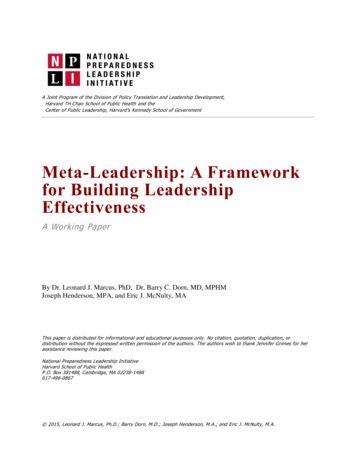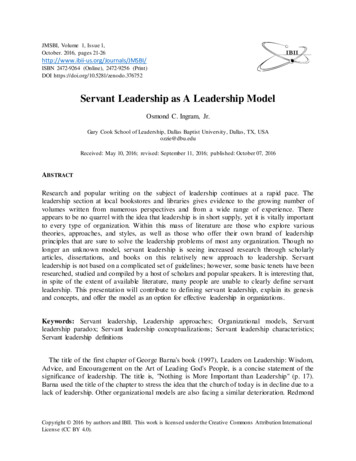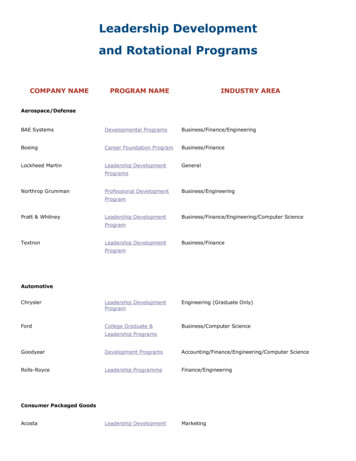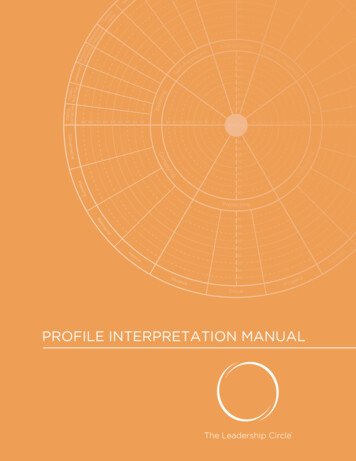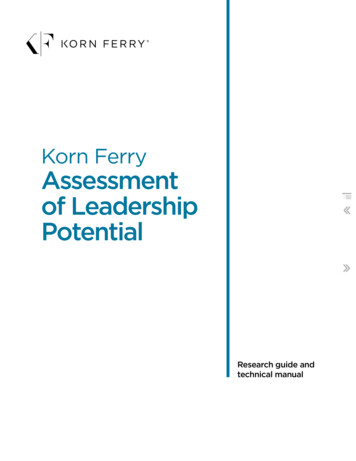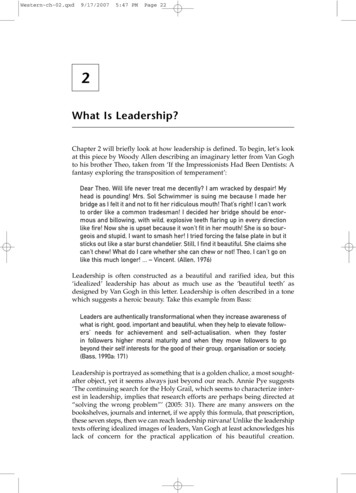
Transcription
Western-ch-02.qxd9/17/20075:47 PMPage 222What Is Leadership?Chapter 2 will briefly look at how leadership is defined. To begin, let’s lookat this piece by Woody Allen describing an imaginary letter from Van Goghto his brother Theo, taken from ‘If the Impressionists Had Been Dentists: Afantasy exploring the transposition of temperament’:Dear Theo, Will life never treat me decently? I am wracked by despair! Myhead is pounding! Mrs. Sol Schwimmer is suing me because I made herbridge as I felt it and not to fit her ridiculous mouth! That’s right! I can’t workto order like a common tradesman! I decided her bridge should be enormous and billowing, with wild, explosive teeth flaring up in every directionlike fire! Now she is upset because it won’t fit in her mouth! She is so bourgeois and stupid, I want to smash her! I tried forcing the false plate in but itsticks out like a star burst chandelier. Still, I find it beautiful. She claims shecan’t chew! What do I care whether she can chew or not! Theo, I can’t go onlike this much longer! . – Vincent. (Allen, 1976)Leadership is often constructed as a beautiful and rarified idea, but this‘idealized’ leadership has about as much use as the ‘beautiful teeth’ asdesigned by Van Gogh in this letter. Leadership is often described in a tonewhich suggests a heroic beauty. Take this example from Bass:Leaders are authentically transformational when they increase awareness ofwhat is right, good, important and beautiful, when they help to elevate followers’ needs for achievement and self-actualisation, when they fosterin followers higher moral maturity and when they move followers to gobeyond their self interests for the good of their group, organisation or society.(Bass, 1990a: 171)Leadership is portrayed as something that is a golden chalice, a most soughtafter object, yet it seems always just beyond our reach. Annie Pye suggests‘The continuing search for the Holy Grail, which seems to characterize interest in leadership, implies that research efforts are perhaps being directed at“solving the wrong problem”’ (2005: 31). There are many answers on thebookshelves, journals and internet, if we apply this formula, that prescription,these seven steps, then we can reach leadership nirvana! Unlike the leadershiptexts offering idealized images of leaders, Van Gogh at least acknowledges hislack of concern for the practical application of his beautiful creation.
Western-ch-02.qxd9/17/20075:47 PMPage 23WHAT IS LEADERSHIP?23Leadership is portrayed in this seductive manner, to sell leadership booksand training courses, and to meet the demand for easy answers and quicksolutions. However, at best, these easy solutions are fairly useless in practice,and can be harmful and misleading (Gemmil and Oakley, 1992). To movebeyond the idealistic, this chapter will try to get beneath the surface of thequestion, what is leadership?There are almost as many different definitions of leadership as there arepersons who have attempted to define the concept. (Stodgill, 1974: 259)Dubrin (2000) estimates there are 35,000 definitions of leadership in academic literature. (Pye, 2005: 32)Leadership is a common term but it has many diverse meanings, it has beensaid that, like beauty, you will know leadership when you see it. This, however,means that leaders and leadership are defined in the eye of the beholder. If thisis the case, then there is a multitude of definitions and understandings of whatit means to be a leader or to witness leadership. Barnard ([1938] 1991: 81) identified that ‘lead’ is both a noun and a verb and therefore has a double meaning.The noun could mean ‘to guide others, to be the head of an organization’, whilethe verb could mean ‘to excel and to be in advance’. Likewise, leadership isused to describe a certain type of social interaction between people and theterm leader is used to denote a person (or sometimes a group/company) whohas influence over others (Yukl, 2002; Northouse, 2004). The term leadership isalso used to describe personality traits, behaviours and also to denote the rolesof individuals and collectives. Leadership is inherently complex and is not easily definable; in fact, it is unlikely that any consensus on the term will be found(Grint, 1997). However, leadership does have shared meanings, depending onthe social group you are discussing it with. Most commonly, the term leadership refers to an individual’s role or their traits and behaviours as in ‘she or heshowed leadership’.When leadership is restricted to this populist meaning, it has limitationsthat create difficulties when attempting to change organizations. When onetries to implement leadership and change, it soon becomes clear that leadership does not simply belong to any one individual and that to understandhow leadership works in practice a broader and more in-depth view of leadership must be taken. Northouse (2004: 3) reviewing leadership theory identified four common themes:1234Leadership as a process.Leadership involves influence.Leadership occurs in a group context.Leadership involves goal attainment.Keith Grint identifies a similar four-fold leadership typology of Person,Results, Process and Position (Grint, 2005).The relationship between leadership and followership and the processof leadership as a social interaction has become a focal point for critical
Western-ch-02.qxd9/17/20075:47 PMPage 2424CHAPTER 2theorists to explore (Grint, 2005; Collinson, 2006). This is in contrast to themainstream focus on leaders as individuals and their behaviours, traits andcompetencies using positivist theoretical frameworks.Leadership styles and types comprise an ever growing list as the searchfor the ideal leader continues unabated. Box 2.1 gives some examples of theleadership styles currently in circulation.Box archalParticipativeLeadership stylesPatriarchalPost-modernPost-heroicPrimal emotionalPrinciple-centredRelationalServant leaderSituatedSpiritualStrategicTechnicalThought adership has increasingly become the focus of attention of managementliterature and executive education in recent years, pushing management intoits shadow. Everybody, it seems, wants to be a leader rather than a manager.Kets de Vries notes that in the leadership bible Stogdills Handbook ofLeadership, an increase in articles on effective leadership studies has grownsince 1974, ‘from 3000 to 5000 in seven years, a pace of publication that hasaccelerated ever since’ (in Grint, 1997: 250). Kets de Vries then describes thecontents of these articles as ‘plodding and detached, often far removed fromthe reality of day-to-day life’ (1997: 251). Smith (1997) cites a survey of 250British Chief Executives who were asked to identify the most importantmanagement skills for ensuring business success, and leadership emerged asthe top ranked item. The question then is, what do they mean by leadership?While the leadership literature gains increasing popularity and momentum,it is also problematical in many areas. Much of what is regarded as new leadership literature simply recycles previous management/leadership theories.A great deal of leadership theory is critiqued as over-simplistic, reductionistand offering unrealistic solutions to complex problems:
Western-ch-02.qxd9/17/20075:47 PMPage 25WHAT IS LEADERSHIP?25It may make good politics eventually, here and there, for a leader to say outloud ‘Those who claim to know what to do are either fools or liars and, bygratuitously claiming certainty about cause and effect, they forecloseexperimenting with additional options.’ (Judge, 1994: 78)This also applies to leadership research: ‘Despite all the hype about a“new paradigm” for studying leadership, most of the research usesthe same superficial methods that have been prevalent for decades’ (Yukl,1999: 42).Calas and Smircich critique Peters and Waterman’s (1982) so-called innovative text, In Search of Excellence, and their celebrated transcendent leader:‘Under the guise of “newness’’ the authors do no more than articulate someempty discourses from the 1980s, while returning to the beginning of thecircle’ (1991: 589). They refer to the transcendent leader being a reinventionof the popular ‘Transformational leadership’ (Burns, 1978) which they consider to be ‘empty discourses’ and the full circle they refer to is ChesterBarnard’s work ‘The Functions of the Executive’, written in 1938. This is acommon trend in the leadership literature where a subtle rewriting of existing theory takes place with new nuances and a different terminologyapplied. For example, the ‘great man’ theory, or hero leader of the classictradition becomes in the populist leadership press (there are importantdifferences which will be explored later in the book) the exciting and newTransformational leader of the 1980s. The Transformational leader thenmutates into Peters and Waterman’s Transcendental leader. The main bodyof leadership literature focuses on solo-actors and individual leadershiptraits and competencies. This is widely critiqued by a small minority of critical and systems management thinkers, for example, Barley and Kunda(1992), Casey (1995), Calas and Smircich (1995), Tourish and Pinnington(2002). A variety of critiques and potential solutions are offered in an attemptto make sense of how globalization and technological change impact onthe workplace, with some new and interesting drawing on post-modernand deconstructionist theories from the new philosophers, for example,Lyotard (1984), Derrida (1982). Other critiques, like their counterparts in themainstream literature, recycle ‘radical’ theories in an attempt to recover pastideologies. The post-war social democratic and the social movements of the1960s are the most common source drawn upon, which pursued greaterdemocratic and collectivized leadership or leaderless organizations andlinked them with identity politics.To summarize: leadership is a growth industry and remains a ‘sexy concept’and a buzz word in Business Schools, organizations and social/politicalarenas. However, much of the mainstream literature is adapted and recycledtheory; old news under a new headline. Another of the main problems whenreading the leadership literature is that of reductionist theorizing. Thereappears to be two main reasons for this. First, the mainstream leadership literature is dominated by work from US Business Schools where there is traditionally a focus on positivistic, scientific approaches to management and
Western-ch-02.qxd269/17/20075:47 PMPage 26CHAPTER 2leadership that creates a reductionist tendency (Mintzberg, 2004a). Second,the huge business of executive education creates a reductionist pressure;simple solutions are simply an easier sell. A Google search of leadership andexecutive education courses, consultancy interventions on leadership, or alook at airport bookshops will all provide testimony to the love of the easyanswer and the quick fix solution. Leadership is thus ‘dumbed down’ for thecommercial and consumer society in which we live. This reductionism hashad a limiting impact on leadership thinking and its most common manifestation is to reduce the complexity of leadership to its most easily understood form: the leader as a solo actor, i.e. the leader as individual. Theconsequence is that the dominant focus of leadership research and development is the traits and competencies an individual must have to become abetter leader. As the book will demonstrate, this marginalizes attempts toproblematize leadership, to ask important but difficult questions and toembrace complexity and uncertainty. However, by taking the more challenging critical approach to leadership, there is the hope that we may findmore sustainable and realistic leadership solutions, which are greatlyneeded in our institutions. To take this route we must accept that the solutions we find will be partial, and acknowledge that our work will be part ofan ongoing learning process rather than finding a concrete and finite answer.Leaders and leadership: individuals, collectives orprocess?As already highlighted, there is much confusion and debate within theliterature as to what constitutes leadership. Leadership is most commonlyreferred to and researched as the property of an individual actor, where a leaderdemonstrates leadership through their personal characteristics and how theybehave or act. This view of leadership is culturally coherent, a westernizedunderstanding of individuals where society is viewed as an aggregation ofindividuals (Luke, 1998); it also fits our heroic narratives seen in history, storiesand films. The individual leader is the commonest representation of leadershipmainly because it simplifies a complex phenomena. However, as the followingstatements show, leadership is much more: She was a courageous leader.The board showed great leadership.Scandinavia takes a lead on social welfare.Apple consistently demonstrate leadership in innovation and design.The Arab league showed leadership in the talks and the tensionssubsided. An innovative leadership culture flourished in the company.As these examples show, leadership can be situated within individuals,groups, whole organizations, nations and even within company culture,suggesting a dispersed leadership process.
Western-ch-02.qxd9/17/20075:47 PMPage 27WHAT IS LEADERSHIP?27Leadership is regarded within the critical literature as a process based oninteractions and social relations between people (Senge, 1990; Yukl, 1998;Alvesson, 2002; Burgoyne and Pedler, 2003). Leadership cannot exist solelywithin an individual, as at least one other person (a follower) is required forleadership to be enacted. It is this relationship between the individual andthe follower that establishes leadership, it takes two (or more) to tango, as thesaying goes. This is not to deny the influence and agency of an individual whocan show leadership qualities, for example, Nelson Mandela, Ghandi andMargaret Thatcher, Jack Welch, Steve Jobs, are widely cited as such leaders.Individuals are also elected and given authority as leaders to make decisions. Leadership is sometimes consciously held up as a collective act forexample: a government representing a nation may show leadership to othernations over some contested issue, such as world debt relief. A political partycan show leadership, a cabinet within government or a board of directorscan take collective decisions and show leadership. Some theorists claim thatall leadership is essentially collective leadership, Senge (1990), has definedleadership as ‘the collective capacity to create useful things’ and Collinsonstates, ‘In effect, leadership is the property and consequence of a communityrather than the property and consequence of an individual leader’ (2006: 183).Burgoyne and Pedler sum up the common view taken by those advocatinga more critical and collective approach to leadership, which they call a ‘newview of leadership’:Our approach is based on three core beliefs; leadership should be more: Focused on challenges rather than upon the person. Collective and less individualised. Various and less one-size-fits all.However, like the criticisms of Transformational leadership re-inventing‘Great Man’ theory, much of the collective leadership literature re-visitsdemocratic and collectivist theories that arose from social liberation movements, which often had an anti-leadership stance (emerging from NaziGermany, Stalinism, and other examples of leaders abusing their power).This becomes problematic when discussing what is good leadership, if thereis an underlying distrust of all leadership.Critical theorists now interpret leadership in a more complex way, whichextends the idea of leadership beyond the individual, adding breadth to thedebate. This breadth can work both ways, it can broaden the view of leadership in a useful way but at the same time leadership can appear to be everywhere, as the panacea for all problems. Alvesson argues that the currentpopularity of leadership means that it colonizes social and personal life:There is a tendency for ‘leadership’ to colonise a wider spectrum of socialand personal life. At least in Sweden, leadership is increasingly viewed asa solution also in work areas and professions where self-governance is –or used to be seen as – the norm, like in schools, universities and thechurch. (Alvesson, 2003: 13)
Western-ch-02.qxd289/17/20075:47 PMPage 28CHAPTER 2The popularity of leaderism can also lead to the colonization of the discourses which in the past have been about teamwork, communication,group dynamics, self-management and self-governance etc. This is true ofmainstream and critical theorist perspectives.There are many diverse assumptions made about leaders; the most commonperception that persists is the leader as a heroic individual, with maleattributes – the ‘Great Man’ theory, who now appears in many theoreticalguises. A minority, but important, view is that leadership is sociallyconstructed or regarded as a process (Douglas, 1983; Grint, 1997). Both arguments have their merits but the debate can easily become polarized, one side(the mainstream) researching and debating individuals as leaders, the otherside advocating a social-process leadership theory. There is little clarity inthe literature, and, in my experience, even less in practice, as to how individual leaders and collective actors relate or how the role of the individualleader fits into the social process of leadership.One of the key themes from the literature is that, in the past, leadershiphas been seen as an elitist activity related to power and to hierarchy. Todayit is commonly agreed that leadership is needed at all levels of organizations.Distributive or dispersed leadership are very popular concepts and relate tothe changing post-industrial work conditions that cannot be managed in atop-down, expert, command and control structure. Daniel Golemandescribes this distributive leadership as ‘every person at entry level who inone way or another, acts as a leader’ (2002: 14).Elmore agrees, ‘[in] knowledge intensive enterprises like teaching andlearning there is no way to perform these complex tasks without widely distributing the responsibility for leadership among roles in the organization’(2000: 14). The aim is to maximize the human potential of an organization(Western, 2005). However to achieve an understanding of leadership, one ofthe key issues which is under-researched and hugely problematic is the relationship between the individual and the group. Turning to psychoanalytictheory, Wilfred Bion, a Tavistock psychoanalyst, describes the difficulty individuals have in managing their relationship to groups, describing the internaltension an individual has between the self and being a ‘group animal’: ‘Theindividual is a group animal at war, not simply with the group, but withhimself for being a group animal and with those aspects of his personalitythat constitute his “groupishness”’ (Bion, 1961: 131).Sigmund Freud in Civilisation and its Discontents (1930) identified the struggle individuals face to maintain autonomy and be part of a social and civilizedgroup which always limits this autonomy. Civilization (group living)demands limits on our unconscious and primitive drives and emotions, forexample, our innate biological sexual and aggressive drives. These are bothessential and dangerous for group survival. These tensions are played out verymuch through leadership that represents an active element in this struggle. Theleader or leadership of any social group; team, community or nation, oftenbecomes the focal point, the object which represents this boundary betweenthe individual and the group. Perhaps this is why leadership is such anemotive and important issue to each of us, why we love to criticize or idealize
Western-ch-02.qxd9/17/20075:47 PMPage 29WHAT IS LEADERSHIP?29leaders. It is rarely that we do not have an emotional response to George Bush,Tony Blair, the national sports coach, or the boss at work.Bion cites Freud (1921: 3) who points out that individual and grouppsychology cannot be absolutely differentiated because the psychology of theindividual is itself a function of the individual’s relationship to another personor object. Bion continues: ‘The individual cannot help being a member of agroup even if his membership of it consists in behaving in such a way as to givereality to the idea that he does not belong to a group at all’ (1961: 131). A monkliving in a solitary cell is an example of this; while physically isolating himself,he remains very prominent (a powerful symbol) in the minds of the community he has left and vice versa. He is also connected to his monastic communityin spite of his choice of being alone. It is a common preference for theoriststo reduce the relationship between the individual and the group to either/orscenarios. A major task in my work as a leadership developer, and leadershipcoach is to continuously find ways to help HR Directors and Senior executivesto think beyond developing individual leaders through coaching or competency frameworks, and to link individual development to organizational development and culture change. There is a huge block in making this link, andeither/or scenarios are much too common: ‘Should we put our efforts into O.D(organisational development) and culture change or personally develop thehigh potential leaders?’ Individual approaches to leadership such as traits,behaviours and competencies ignore the dynamics and emotions of the role offollowers, i.e. they ignore the group. Social construction and collectiveapproaches to leadership focus on the process, and the group, minimizing therole of the individual. This book will attempt to work across the boundaries ofleadership, understanding how it is both a process and also how individualleadership is very real and a necessary part of the leadership process.Defining leaders by their traits and competenciesOne of the most common ways to define leadership is through observingindividual leaders and analysing their internal personality traits whichmake them successful leaders. This approach fits within the individualisticleadership camp. Today the multi-million dollar business of leadershipdevelopment tends to focus on developing leadership traits and competencies. There has been a long search historically to try and define what aspectsof the personality (what traits) make a good leader. Observations and studiesof different exceptional leaders try and identify what aspects of theirpersonality enabled them to be ‘great men’ (as the studies were usually onmale heroic figures) and examples such as courage, charisma, vision, fortitude were identified as traits to be exemplified. This focus on the innate personality of leaders was known as ‘Great Man’ theory. Another approachwhich closely relates to, and often arises from, behavioural and cognitivebehavioural psychology attempts to identify what leaders do, rather thanwhat their personalities consist of. This approach has an individualistic and
Western-ch-02.qxd9/17/20075:47 PM30Page 30CHAPTER 2functionalist approach in that it isolates component parts of an individual’sbehavioural repertoire with the aim of being able to modify and developpotential leader’s behaviour, in order to improve their leadership skills andabilities. This approach is reductionist as it attempts to reduce leadership toa finite set of behaviours. Having identified the traits and competencies thatgood leaders have, individuals are trained and tested against this list toimprove these competencies. I will briefly summarize and critique the traitand competency approach, in order to address the complexity of leadership.A classic piece of trait theory in management came from McGregor in the1960s and perhaps best sums up trait theory; it is very over-simplistic focusing on the individual and dividing humanity into two main camps: TheoryX and Theory Y (Box 2.2). This approach is still taught in many businessschools and can be found in many MBA texts.Box 2.2Theory X or Theory Y type managerFrom Maslow’s work on self-actualization came Douglas McGregor’s(1960) Theory X or Theory Y type manager which offers a polemic oversimplification, yet is still cited in much of the management literature:‘Many managers still easily identify with the Theory X and Y distinctionand its normative view of good and bad leadership’ (Fulop and Linstead,1999: 165).McGregor’s theories present a philosophical stance and are thereforedifficult to validate. McGregor stated that Theory X management/leadership was based on the assumption that:1 The average human being has an inherent dislike of work and willavoid it if at all possible.2 Because of this, most people must be coerced, controlled, directedand threatened with punishment to put adequate effort into theachievement of organizational objectives.3 The average human being prefers to be directed, wishes to avoidresponsibility, has relatively little ambition and wants security aboveall else.Theory Y of management/leadership represents the other view that:1 Work is natural.2 People will exercise self direction.3 Satisfaction and self-actualization are the most important rewardsfor individuals.4 Individuals seek responsibility and development and the averageperson’s potential is not being fully used.(McGregor, 1960: 33–4)(Continued)
Western-ch-02.qxd9/17/20075:47 PMPage 31WHAT IS LEADERSHIP?31(Continued)McGregor did say that Theory X was an acceptable style at certaintimes, perhaps during economic recession, for example, but in generalthere was one best way of management and that was Theory Y. TheoryX led to a more autocratic leadership style because of the need to controland coerce unwilling workers whereas Theory Y built relationships andencourages a participative leadership style.This example of trait theory shows how people are divided into functionalgroups, in this case, you are an X or Y type. There are numerous examplesin the leadership literature of competency and trait approaches. There arethousands of tests: personality tests, psycho-metric tests and frameworks,which attempt to assess leaders. The tests give a pseudo-scientific empiricallegitimacy to this approach to understanding leadership and leader development. The popularity of the tests and this approach rely on two fundamental observations:1 People seem inherently curious about themselves and simplistic answersto the complex problems of personality grab the attention of the individual. Check any magazine rack and the internet for tests to show whattype of person you are, and you will be inundated with results. I amalways amazed how a buzz enters the university lecture theatre whengroups are asked to undertake and discuss their Myers Briggs Test ortheir Enneagram. As a trainer, it is an almost failsafe way to have a successful seminar, these tests engage immediately with our ego states andour narcissism! Personality tests are used as sales tools because of theirpopularity, which helps explain the growth in leadership testing.2 Companies and organizations get a formulaic simplistic quasi-scientificand measurable solution (always popular in the rational-positivist worldof management) to the very difficult and complex challenge of leadershipdevelopment.Manfred Kets de Vries finds the literature on leadership traits overwhelmingand confusing but identifies some commonality in the findings: ‘conscientiousness, extroversion, dominance, self-confidence, energy, agreeableness,intelligence, openness to experience and emotional stability’ (Kets de Vries,1994). As Kets de Vries points out, these traits are very open-ended and,when discussed, they open up a heated polemic as to the nature of what theyreally mean. He goes on to say how individuals’ characters need to beassessed using clinical methodologies (Kets de Vries is a psychoanalyst andDirector of Insead Global Leadership Center, Insead Business School,France). Many of the traits identified are the obvious traits which could beapplied to anybody who is successful in multiple dimensions beyond theidea of leadership. Gemmil and Oakley (1992) identify a resurgence in the
Western-ch-02.qxd329/17/20075:47 PMPage 32CHAPTER 21990s of the ‘traitist’ approach, identifying charisma as an embodiment ofthis approach, ‘Charisma is the leadership trait most often examined bymembers of the “leadership mafia”’ (in Grint, 1997: 277). Gemmil andOakley’s anti-leadership polemic names Bennis and Nanus (1985), Zaleznik(1989) and Tichy and Devanna (1986) as part of the new wave of leadershiptheorists drawing on the trait approach. They link the resurgence of leadership and the trait approach in particular as part of a Great Leader Mythwhich undermines autonomy and creates dependency (this will be revisitedlater in the book in some depth). Having worked with leadership tests inexecutive education, one of the real strengths of this approach is thatalthough the focus is on an individual and is reductionist, it can act as acatalyst for a broader discussion about leadership and can offer a commonlanguage for a group or organization to discuss some of the leadership issuesit faces. Too often, however, this strength is overlooked as individuals areencouraged to focus on their own performance.The most common criticism of the trait/competency approach is that theyare one-size-fits-all approaches. Defining leadership by a set of given competencies or traits suggests a preferred leadership style which all individualsmust have if they are to be successful leaders. These approaches are limitedin two important areas: first, from a critical theorist perspective, they represent a hegemonic approach. This refers to an elite powerful group, i.e. thesenior management team
Leadership has increasingly become the focus of attention of management literature and executive education in recent years, pushing management into its shadow. Everybody, it seems, wants to be a leader rather than a manager. Kets de Vries notes that in th


